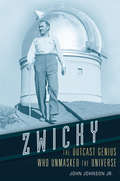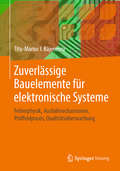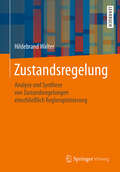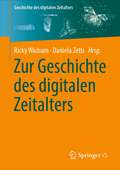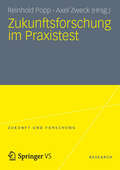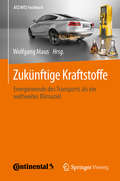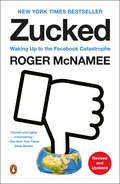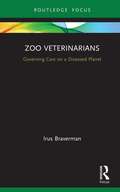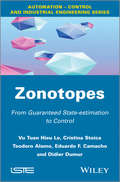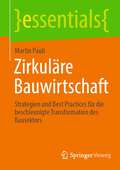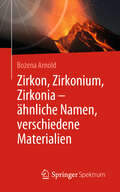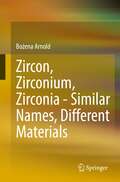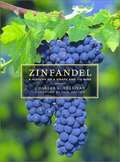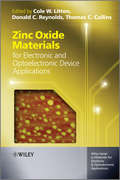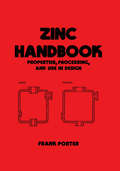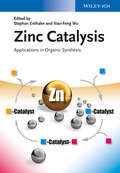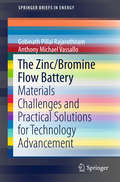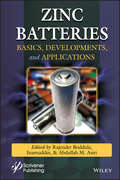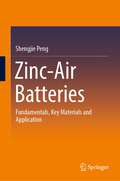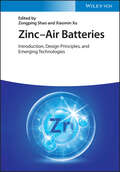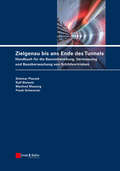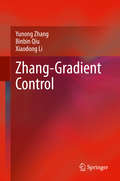- Table View
- List View
Zwischenlagerung hoch radioaktiver Abfälle: Randbedingungen und Lösungsansätze zu den aktuellen Herausforderungen (Energie in Naturwissenschaft, Technik, Wirtschaft und Gesellschaft)
by Dennis Köhnke Manuel Reichardt Franziska SemperIn diesem Buch findet der Leser die technischen, rechtlichen und ethischen Hintergründe zur Lagerung radioaktiver, Wärme entwickelnder Abfälle. <P>Die Rolle der Oberflächenlagerung in einer Entsorgungsstrategie ist ebenso besprochen wie Arten und prognostizierte Mengen an hoch radioaktiven Reststoffen, der Transport und die Lagerbehälter oder die Anforderungen an ein Zwischenlagerbauwerk als langfristig wirksame, vollwertige mechanische Barriere. Die Rechtslage ist erörtert und das Thema Gerechtigkeit wird thematisiert. Abschließend wird ein Überblick über die Managementstrategie für radioaktive Abfälle in den Niederlanden gegeben.
Zwicky: The Outcast Genius Who Unmasked the Universe
by John Johnson Jr.Fritz Zwicky was one of the most inventive and iconoclastic scientists of the twentieth century. Among other accomplishments, he was the first to infer the existence of dark matter. He also clashed with better-known peers and became a pariah in the scientific community. John Johnson, Jr.,’s biography brings this tempestuous maverick alive.
Zuverlässigkeit im Fahrzeug- und Maschinenbau: Ermittlung von Bauteil- und System-Zuverlässigkeiten
by Bernd Bertsche Martin DazerVon immer komplexer werdenden technischen Produkten erwartet man heute nicht nur gesteigerte Leistungsfähigkeit, sondern auch erhöhte Zuverlässigkeit. Dieses Lehrbuch ist sowohl eine Einführung in die Zuverlässigkeitstheorie für Fahrzeug- und Maschinenbauingenieure als auch ein Nachschlage- und Vertiefungswerk für Zuverlässigkeitsspezialisten. Neben den praxisrelevanten statistischen Grundlagen und den qualitativen Zuverlässigkeitsmethoden wie der FMEA und der FTA befasst sich dieses Lehrbuch schwerpunktmäßig mit der Lebensdauerdatenanalyse und den Zuverlässigkeitstestmethoden.Der Stoff ist theoretisch fundiert und zugleich praxisnah aufbereitet. Aufbau und Darstellungsweise machen ein unmittelbares Arbeiten mit dem Buch möglich. Vertieft werden die beschriebenen Theorien, Begriffe und Vorgehensweisen durch Beispiele und Übungen mit Lösungen.Für diese Neuauflage wurde, neben der Erweiterung und Überarbeitung der Kapitel, ein neues Kapitel zum Thema Prognostics & Health Management (PHM) aufgenommen. Darin werden die neuesten Ansätze der Zuverlässigkeitsabsicherung mittels Health-Monitoring und Prognose der verbleibenden Restlebensdauer vorgestellt.
Zuverlässige Bauelemente für elektronische Systeme: Fehlerphysik, Ausfallmechanismen, Prüffeldpraxis, Qualitätsüberwachung
by Titu-Marius I. BăjenescuSpeicher, Mikroprozessoren, Opto-, MEMS- und NEMS-Bauteile zusammen mit den passiven Komponenten sind das Hauptthema des Buches. Praktische Methoden zur Untersuchung der Zuverlässigkeit sind ergänzt durch umfangreiche Tabellen und veranschaulicht durch zahlreiche Diagramme. Damit erhält der Leser präzise, praxisnah und umfassend sämtliche Zuverlässigkeitsaspekte einfacher und komplexer elektronischer Bauelemente - von der Fehlerphysik über die Prüffeldpraxis und Ausfallmechanismen bis zur Qualitätsüberwachung.
Zustandsregelung: Analyse und Synthese von Zustandsregelungen einschließlich Regleroptimierung
by Hildebrand WalterDas Buch beschreibt dynamische Systeme im Zustandsraum sowie deren Überprüfung auf Steuerbarkeit und Beobachtbarkeit. Ebenso wird das Berechnen von Systemantworten, das Dimensionieren von Zustandsregelkreisen nach dem Verfahren der Polvorgabe sowie die Optimierung von Zustandsreglern (Riccatti-Regler) behandelt.
Zur Geschichte des digitalen Zeitalters (Geschichte des digitalen Zeitalters)
by Ricky Wichum Daniela ZettiIn der zweiten Hälfte des 20. Jahrhunderts bearbeiteten westliche Gesellschaften Digitales in vielfältigen Gestaltungsräumen und verlagerten das digitale Zeitalter immer wieder in neue Zukünfte. Der Sammelband verfolgt technik-, sozial- und kulturhistorische Fragestellungen zur Transformation des Digitalen. Die Beiträge analysieren die mannigfaltigen Anpassungs- und Synchronisierungsprozesse zwischen digitalen Medienumbrüchen und sozialstruktureller Veränderung. Wandel wird durch Technik – mal mit ihr, mal gegen sie – gestaltet.
Zukunftsweisende Teamsteuerung: Ambidextre Führung als eine neue Form organisatorischer Intelligenz (AutoUni – Schriftenreihe #151)
by Jessica GuthZweifelsfrei benötigen Organisationen vor allem in ‚turbulenten Zeiten‘ eine besonders überzeugende Lösung, wie einzelne Mitarbeiter ihr Potential entfalten können. Diese Arbeit zeigt auf, dass Teams eine neue Funktion bekommen, wenn sie in der Phase zwischen ‚nicht mehr‘ und noch nicht‘ vielversprechende Leistungen vollbringen können. Im Rahmen einer Erst- und Folgeuntersuchung führte Jessica Guth bei einem Großunternehmen der Automobilbranche zahlreiche Gruppendiskussionen und Experteninterviews durch. Ihre These: Kontextuell ambidextres Führungshandeln ist das Ziel, darf aber nicht an Paradoxien scheitern, denn nur so können Lernprozesse im Team Exploitation und Exploration auslösen. Das ermittelte 3L-Modell ambidextrer Führung (Lernen, Lenken, Leisten) wird in einem Rahmenmodell zusammengefasst, um auch Führung weiter zu denken. Insbesondere der Zusammenhang zwischen ambidextrer Führung und innovativer Ideengenerierung wird beleuchtet, so dass bedeutsame Anregungen zur Ideengenerierung in nachhaltigkeits- und lerntheoretischer Perspektive vorliegen.
Zukunftsforschung im Praxistest
by Reinhold Popp Axel ZweckWie funktioniert angewandte Zukunftsforschung bei der Allianz, bei BASF, der Deutschen Bahn, BMW, Siemens, aber auch in mittelständischen Unternehmen? Wie analysieren zwei Fraunhofer-Institute, das IZT, der Verein Deutscher Ingenieure, Z-Punkt und das Zentrum für Zukunftsstudien als Think Tank der Salzburger Sozialpartner wichtige Zukunftsthemen und Zukunftstechnologien? Die Antworten auf diese zukunftsweisenden Fragen finden sich in diesem Band. Renommierte ZukunftsexpertInnen zeigen, wie sich Unternehmen, Organisationen und Institutionen mit dem Wissen von heute auf die Welt von morgen vorbereiten.
Zukünftige Kraftstoffe: Energiewende des Transports als ein weltweites Klimaziel (ATZ/MTZ-Fachbuch)
by Wolfgang MausDas Buch ist als Kompendium angelegt und deckt das Wissen von Gesetzes-, Verbands- und Wirtschaftssektoren ab, die für die zukünftige nachhaltige Mobilität von entscheidender Bedeutung sind: 1. Regulatorische und umweltpolitische Randbedingungen; 2. Energiebereitstellung, Sektorkopplung, wirtschaftliche Bedeutung; 3. Nachhaltige Kraftstoffe für die Energiewende im Transport-, Verkehrssektor; 4. Anwendung synthetischer Otto- und Dieselmotorkraftstoffe.
Zucked: Waking Up to the Facebook Catastrophe
by Roger McNameeThe story of how a noted tech venture capitalist, an early mentor to Mark Zuckerberg and investor in his company, woke up to the serious damage Facebook was doing to our society and set out to try to stop it. <P><P>If you had told Roger McNamee even three years ago that he would soon be devoting himself to stopping Facebook from destroying our democracy, he would have howled with laughter. He had mentored many tech leaders in his illustrious career as an investor, but few things had made him prouder, or been better for his fund's bottom line, than his early service to Mark Zuckerberg. Still a large shareholder in Facebook, he had every good reason to stay on the bright side. Until he simply couldn't. <P><P>ZUCKED is McNamee's intimate reckoning with the catastrophic failure of the head of one of the world's most powerful companies to face up to the damage he is doing. It's a story that begins with a series of rude awakenings. First there is the author's dawning realization that the platform is being manipulated by some very bad actors. <P><P>Then there is the even more unsettling realization that Zuckerberg and Sheryl Sandberg are unable or unwilling to share his concerns, polite as they may be to his face. And then comes the election of Donald Trump, and the emergence of one horrific piece of news after another about the malign ends to which the Facebook platform has been put. To McNamee's shock, even still Facebook's leaders duck and dissemble, viewing the matter as a public relations problem. Now thoroughly alienated, McNamee digs into the issue, and fortuitously meets up with some fellow travelers who share his concern, and help him sharpen its focus. <P><P>Soon he and a dream team of Silicon Valley technologists are charging into the fray, to raise consciousness about the existential threat of Facebook, and the persuasion architecture of the attention economy more broadly -- to our public health and to our political order. Zucked is both an enthralling personal narrative and a masterful explication of the forces that have conspired to place us all on the horns of this dilemma. <P><P>This is the story of a company and its leadership, but it's also a larger tale of a business sector unmoored from normal constraints, just at a moment of political and cultural crisis, the worst possible time to be given new tools for summoning the darker angels of our nature and whipping them into a frenzy. <P><P>Like Jimmy Stewart in Rear Window, Roger McNamee happened to be in the right place to witness a crime, and it took him some time to make sense of what he was seeing and what we ought to do about it. The result of that effort is a wise, hard-hitting, and urgently necessary account that crystallizes the issue definitively for the rest of us. <P><b>A New York Times Bestseller</b>
Zoo Veterinarians: Governing Care on a Diseased Planet (Law, Science and Society)
by Irus BravermanDespite their centrality to the operation of contemporary accredited zoo and aquarium institutions, the work of zoo veterinarians has rarely, if ever, been the focus of a critical analysis in the social science and humanities. Drawing on in-depth interviews and observations of zoo and aquarium veterinarians in Europe and North America, this book highlights the recent transformation that has occurred in the zoo veterinarian profession during a time of ecological crisis, and what these changes can teach us about our rapidly changing planet. Zoo vets, Braverman instructs us with a wink, have "gone wild." Originally an individual welfare-centered profession, these experts are increasingly concerned with the sustainability of wild animal populations and with ecological health. In this sense, the story of zoo vets "going wild"—in their subjects of care, their motivations, and their ethical standards, as well as in their professional practices and scientific techniques—is also a story about zoo animals gone wild, wild animals encroaching the zoo, and, more generally, a wild world that is becoming "zoo-ified." Such transformations have challenged existing norms of veterinary practice. Exploring the regulatory landscape that governs the work of zoo and aquarium veterinarians, Braverman traverses the gap between the hard and soft sciences and between humans and nonhumans. At the intersection of animal studies, socio-legal studies, and Science and Technology Studies, this book will appeal not only to those interested in zoos and in animal welfare, but also to scholars in the posthumanities.
Zonotopes: From Guaranteed State-estimation to Control
by Vu Tuan Le Cristina Stoica Teodoro Alamo Eduardo F. Camacho Didier DumurThis title focuses on two significant problems in the field of automatic control, in particular state estimation and robust Model Predictive Control under input and state constraints, bounded disturbances and measurement noises. The authors build upon previous results concerning zonotopic set-membership state estimation and output feedback tube-based Model Predictive Control. Various existing zonotopic set-membership estimation methods are investigated and their advantages and drawbacks are discussed, making this book suitable both for researchers working in automatic control and industrial partners interested in applying the proposed techniques to real systems. The authors proceed to focus on a new method based on the minimization of the P-radius of a zonotope, in order to obtain a good trade-off between the complexity and the accuracy of the estimation. They propose a P-radius based set-membership estimation method to compute a zonotope containing the real states of a system, which are consistent with the disturbances and measurement noise. The problem of output feedback control using a zonotopic set-membership estimation is also explored. Among the approaches from existing literature on the subject, the implementation of robust predictive techniques based on tubes of trajectories is developed. Contents 1. Uncertainty Representation Based on Set Theory. 2. Several Approaches on Zonotopic Guaranteed Set-Membership Estimation. 3. Zonotopic Guaranteed State Estimation Based on P-Radius Minimization. 4. Tube Model Predictive Control Based on Zonotopic Set-Membership Estimation. About the Authors Vu Tuan Hieu Le is a Research Engineer at the IRSEEM/ESIGELEC Technopôle du Madrillet, Saint Etienne du Rouvray, France. Cristina Stoica is Assistant Professor in the Automatic Control Department at SUPELEC Systems Sciences (E3S), France. Teodoro Alamo is Professor in the Department of Systems Engineering and Automatic Control at the University of Seville, Spain. Eduardo F. Camacho is Professor in the Department of Systems Engineering and Automatic Control at the University of Seville, Spain. Didier Dumur is Professor in the Automatic Control Department, SUPELEC Systems Sciences (E3S), France.
Zirkuläre Bauwirtschaft: Strategien und Best Practices für die beschleunigte Transformation des Bausektors (essentials)
by Martin PauliDieses Essential fasst prägnant zusammen, warum die Prinzipien der Kreislaufwirtschaft für die Bauwirtschaft im Kontext von Klimawandel und zunehmender Ressourcenknappheit unabdingbar sind. Es gibt Einblicke in Umsetzungsstrategien und Projektbeispiele, beleuchtet die elementaren Methoden zur Messbarkeit von sektorspezifischen CO2-Emissionen und wirft einen systemischen Blick auf die Wertschöpfungskette Bau sowie die Implikationen, Potenziale und Risiken der Umsetzung.
Zirkon, Zirkonium, Zirkonia - ähnliche Namen, verschiedene Materialien
by Bożena ArnoldIm vorliegenden Buch finden Sie viele spannende und oft erstaunliche Informationen über diese außergewöhnlichen und vielfältigen Materialien. Die Darstellung ist im Wesentlichen chronologisch aufgebaut und folgt der Geschichte der Entdeckung dieser Materialien. Dabei werden ihre Eigenschaften und Anwendungsbereiche beschrieben. Das Buch stellt eine Mischung aus Fach- und Sachbuch dar: verständlich für Fachleute und Laien.
Zircon, Zirconium, Zirconia - Similar Names, Different Materials
by Bożena ArnoldIn this book you will find a lot of exciting and often astonishing information about these extraordinary and diverse materials. The presentation is essentially structured chronologically and follows the history of the discovery of these materials. Their properties and areas of application are described. The book is a mixture of specialist and non-fiction: understandable for experts and laypeople.This book is a translation of the original German 1st edition Zirkon, Zirkonium, Zirkonia - ähnliche Namen, verschiedene Materialien by Bożena Arnold, published by Springer-Verlag GmbH Germany, part of Springer Nature in 2019. The translation was done with the help of artificial intelligence (machine translation by the service DeepL.com). A subsequent human revision was done primarily in terms of content, so that the book will read stylistically differently from a conventional translation. Springer Nature works continuously to further the development of tools for the production of books and on the related technologies to support the authors.
Zinfandel: A History of a Grape and Its Wine
by Charles L. SullivanThe Zinfandel grape--currently producing big, rich, luscious styles of red wine--has a large, loyal, even fanatical following in California and around the world. The grape, grown predominantly in California, has acquired an almost mythic status--in part because of the caliber of its wines and its remarkable versatility, and in part because of the mystery surrounding its origins. Charles Sullivan, a leading expert on the history of California wine, has at last written the definitive history of Zinfandel. Here he brings together his deep knowledge of wine with the results of his extensive research on the grape in the United States and Europe in a book that will entertain and enlighten wine aficionados and casual enthusiasts. In this lively book, Sullivan dispels the false legend that has obscured Zinfandel's history for almost a century, reveals the latest scientific findings about the grape's European roots, shares his thoughts on the quality of the wines now being produced, and looks to the future of this remarkable grape. Sullivan reconstructs Zinfandel's journey through history--taking us from Austria to the East Coast of the U. S. in the 1820s, to Gold Rush California, and through the early days of the state's wine industry. He considers the ups and downs of the grape's popularity, including its most recent and, according to Sullivan, most brilliant "up. " He also unravels the two great mysteries surrounding Zinfandel: the myth of Agoston Haraszthy's role in importing Zinfandel, and the heated controversy over the relationship between California Zinfandel and Italian Primitivo. Sullivan ends with his assessments of the 2001 and 2002 vintages, firmly setting the history of Zinfandel into the chronicles of grape history.
Zinc Oxide Materials for Electronic and Optoelectronic Device Applications
by Cole W. Litton Thomas C. Collins Donald C. Reynolds Arthur Willoughby Peter Capper Safa KasapZinc Oxide (ZnO) powder has been widely used as a white paint pigment and industrial processing chemical for nearly 150 years. However, following a rediscovery of ZnO and its potential applications in the 1950s, science and industry alike began to realize that ZnO had many interesting novel properties that were worthy of further investigation.ZnO is a leading candidate for the next generation of electronics, and its biocompatibility makes it viable for medical devices. This book covers recent advances including crystal growth, processing and doping and also discusses the problems and issues that seem to be impeding the commercialization of devices.Topics include:Energy band structure and spintronics Fundamental optical and electronic properties Electronic contacts of ZnO Growth of ZnO crystals and substrates Ultraviolet photodetectors ZnO quantum wells Zinc Oxide Materials for Electronic and Optoelectronic Device Applications is ideal for university, government, and industrial research and development laboratories, particularly those engaged in ZnO and related materials research.
Zinc Handbook: Properties, Processing, and Use In Design (Mechanical Engineering #Vol. 73)
by Frank C. PorterSummarizes information on all aspects of metallic zinc and gives references to additional source material, including major books and reviews. At the heart of the reference are 16 chapters that cover coatings and electrochemical protection of steel by zinc.
Zinc Catalysis
by Xiao-Feng Wu Stephan EnthalerFilling the gap in the market for comprehensive coverage of this hot topic, this timely book covers a wide range of organic transformations, e. g. reductions of unsaturated compounds, oxidation reactions, Friedel-Crafts reactions, hydroamination reactions, depolymerizations, transformations of carbon dioxide, oxidative coupling reactions, as well as C-C, C-N, and C-O bond formation reactions. A chapter on the application of zinc catalysts in total synthesis is also included. With its aim of stimulating further research and discussion in the field, this is a valuable reference for professionals in academia and industry wishing to learn about the latest developments.
The Zinc/Bromine Flow Battery
by Gobinath Pillai Rajarathnam Anthony Michael VassalloThis book presents a detailed technical overview of short- and long-term materials and design challenges to zinc/bromine flow battery advancement, the need for energy storage in the electrical grid and how these may be met with the Zn/Br system. Practical interdisciplinary pathways forward are identified via cross-comparison and comprehensive review of significant findings from more than 300 published works, with clear in-depth explanations spanning initial RFB development to state-of-the-art research in related systems. Promising strategies described include the use of modern electrochemical techniques to study and optimize physical processes occurring within the system during operation, improving zinc electroplating quality during the charge phase through the strategic use of organic additives, as well as identifying suitable catalysts to optimize the bromine/bromide redox couple. The primary focus is on research and development of novel materials in the areas of electrolyte formulation and multifunctional "smart" electrode surfaces to achieve a higher degree of control over processes at the electrode-electrolyte interface. The strategies suggested in this book are also highly adaptable for use in other similar flow battery systems, while the unique cross-comparative approach makes it a useful reference and source of new ideas for both new and established researchers in the field of energy storage and battery technology.
Zinc Batteries: Basics, Developments, and Applications
by Rajender Boddula Inamuddin Abdullah M. AsiriBattery technology is constantly changing, and the concepts and applications of these changes are rapidly becoming increasingly more important as more and more industries and individuals continue to make “greener” choices in their energy sources. As global dependence on fossil fuels slowly wanes, there is a heavier and heavier importance placed on cleaner power sources and methods for storing and transporting that power. Battery technology is a huge part of this global energy revolution. Zinc batteries are an advantageous choice over lithium-based batteries, which have dominated the market for years in multiple areas, most specifically in electric vehicles and other battery-powered devices. Zinc is the fourth most abundant metal in the world, which is influential in its lower cost, making it a very attractive material for use in batteries. Zinc-based batteries have been around since the 1930s, but only now are they taking center stage in the energy, automotive, and other industries. Zinc Batteries: Basics, Developments, and Applicationsis intended as a discussion of the different zinc batteries for energy storage applications. It also provides an in-depth description of various energy storage materials for Zinc (Zn) batteries. This book is an invaluable reference guide for electrochemists, chemical engineers, students, faculty, and R&D professionals in energy storage science, material science, and renewable energy.
Zinc-Air Batteries: Fundamentals, Key Materials and Application
by Shengjie PengThis book aims to discuss the cutting-edge materials and technologies for zinc-air batteries. From the perspective of basic research and engineering application, the principle innovation, research progress, and technical breakthrough of key materials such as positive and negative electrodes, electrolytes, and separators of zinc-air batteries are discussed systematically, which can be used to guide and promote the development of zinc-air battery technology. We do believe that our experiences and in-depth discussions would make this book useful for researchers at all levels in the energy area and provide them with a quick way of understanding the development of zinc-air batteries.
Zinc-Air Batteries: Introduction, Design Principles, and Emerging Technologies
by Zongping Shao Xiaomin XuZinc–Air Batteries Authoritative and comprehensive resource covering foundational knowledge of zinc–air batteries as well as their practical applications Zinc–Air Batteries provides a comprehensive understanding of the history and development of Zn–air batteries, with a systematic overview of components, design, and device innovation, along with recent advances in the field, especially with regards to the cathode catalyst design made by cutting-edge materials, engineering processes, and technologies. In particular, design principles regarding the key components of Zn–air batteries, ranging from air cathode, to zinc anode, and to electrolyte, are emphasized. Furthermore, industrial developments of Zn–air batteries are discussed and emerging new designs of Zn–air batteries are also introduced. The authors argue that designing advanced Zn–air battery technologies is important to the realization of efficient energy storage and conversion—and, going further, eventually holds the key to a sustainable energy future and a carbon-neutral goal. Edited and contributed to by leading professionals and researchers in the field, Zinc–Air Batteries also contains information regarding: Design of oxygen reduction catalysts in primary zinc–air batteries, including precious metals, single-atoms, carbons, and transition metal oxides Design of bifunctional oxygen catalysts in rechargeable zinc–air batteries, covering specific oxygen redox reactions and catalyst candidates Design of three-dimensional air cathode in zinc–air batteries, covering loading of carbon-based and transition metal catalysts, plus design of the three-phase interface Design of electrolyte for zinc–air batteries, including liquid electrolytes (e.g., alkaline) and gel polymer electrolytes (e.g., PVA hydrogel) For students, researchers, and instructors working in battery technologies, materials science, and electrochemistry, and for industry and government representatives for decision making associated with energy and transportation, Zinc–Air Batteries summarizes the research results on Zn–air batteries and thereby helps researchers and developers to implement the technology in practice.
Zielgenau bis ans Ende des Tunnels: Handbuch fur die Bauvorbereitung, Vermessung und Bauuberwachung von Schildvortrieben
by Dietmar Placzek Rolf Bielecki Manfred Messing Frank SchwarzerDamit der fertige Tunnel am Ende seine Funktion erfüllen kann, muss er exakt so liegen, wie er geplant wurde. Einfluss auf die Vortriebsgenauigkeit haben Trassen- und Gradientenplanung, Baugrund- und Grundwasserverhältnisse, das gewählte Vortriebsverfahren, Einwirkungen und Widerstände auf die Vortriebsmaschine sowie die begleitende Bauüberwachung und Kontrolle. Das Handbuch ist Grundlage für die Bauvorbereitung, die Vermessung und Bauüberwachung von Schildvortrieben und gilt gleichermaßen für Rohr- und Tübbingvortriebe, die mit gesteuerten Schildmaschinen durchgeführt werden. Bauherren, Planer, Prüfer und Ausführenden werden dieses Handbuch als technischen Leitfaden für einen sicheren und zielgenauen Vortrieb nutzen. Das Buch ist darüber hinaus auch als Lehrbuch im Rahmen der Aus- und Weiterbildung geeignet.
Zhang-Gradient Control
by Yunong Zhang Binbin Qiu Xiaodong LiThis book introduces readers to using the simple but effective Zhang-gradient (ZG) method to solve tracking-control problems concerning various nonlinear systems, while also highlighting the applications of the ZG method to tracking control for practical systems, e.g. an inverted-pendulum-on-a-cart (IPC) system and a two-wheeled mobile robot (showing its potential applications). In addition to detailed theoretical analyses of ZG controllers, the book presents a wealth of computer simulations to demonstrate the feasibility and efficacy of the controllers discussed (as well as the method itself). More importantly, the superiority of ZG controllers in overcoming the division-by-zero (DBZ) problem is also illustrated. Given its scope and format, the book is well suited for undergraduate and graduate students, as well as academic and industrial researchers in the fields of neural dynamics/neural networks, nonlinear control, computer mathematics, time-varying problem solving, modeling and simulation, analog hardware, and robotics.

